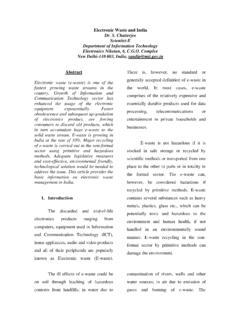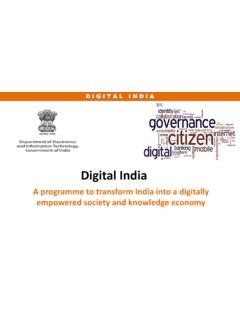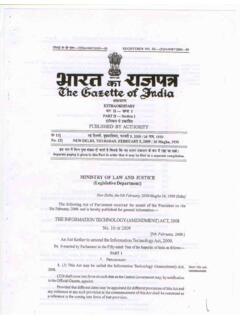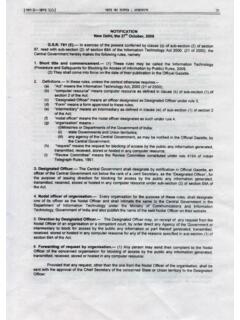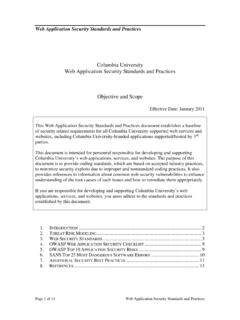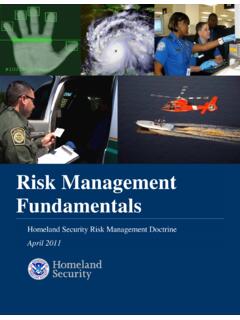Transcription of Cloud Security Best Practices - Ministry of Electronics ...
1 Cloud Security Best Practices Version Ministry of Electronics & Information Technology, Government of India Cloud Management Office Page 2 of 4 DISCLAIMER This document has been prepared by Cloud Management Office (CMO) under Ministry of Electronics and Information Technology (MeitY). This document is advisory in nature and aims to provide information in respect of the GI Cloud (MeghRaj) Initiative. Certain commercial entities, technology, or materials may be identified in this document in order to describe a concept adequately. Such identification is not intended to imply recommendation or endorsement by MeitY. While every care has been taken to ensure that the contents of this Document are accurate and up to date, the readers are advised to exercise discretion and verify the precise current provisions of law and other applicable instructions from the original sources. It represents Practices as on the date of issue of this Document, which are subject to change without notice.
2 The document enlists Practices around basic controls and is not prescriptive in nature. The readers are responsible for making their own independent assessment of the information in this document. In no event shall MeitY or its' contractors be liable for any compensations whatsoever (including, without restriction, damages for loss of profits, business interruption, loss of information) arising out of the use of or inability to use this document. Guidelines/ Best Practices for User Departments on Cloud Security Page 3 of 55 Contents 1. Purpose .. 4 2. Background .. 5 3. Introduction .. 6 Security in Cloud .. 6 Need for Cloud Security .. 8 On-premise Data Centre Security and Cloud Security .. 12 On-premise Data Centre Security .. 13 Cloud Security .. 13 4. Cloud Security Design Principles / 16 5. Guidelines/Best Practices for Cloud Security Adoption .. 16 A Layered Approach towards Security .. 17 Data .. 18 Application .. 20 Host/ Compute .. 24 26 Identity and Access.
3 29 Perimeter and Physical .. 32 Cloud Security Assessment .. 34 Next Generation Model in Cloud Security Zero Trust .. 39 Principles of Zero Trust Model .. 40 Standards applicable for Security .. 42 ISO/ IEC 27000 Family of Information Security Management System .. 42 PCI DSS .. 43 Sector specific standards .. 43 Cloud Security in a Multi- Cloud / Hybrid Cloud environment .. 44 6. Cloud Security Governance .. 48 7. Cloud Security as a shared responsibility model .. 50 Guidelines/ Best Practices for User Departments on Cloud Security Page 4 of 55 1. Purpose This document is prepared to assist the Government Departments in easier understanding & navigating through the best Practices for Cloud Security . Cloud Security is one of the key aspects while considering Cloud deployment options and imbibing the best Practices laid down in this document shall further the Government Department s trust on Cloud and thereby facilitate a better use and adoption.
4 The document has primarily been segmented into 3 sections of which the first section shall deal with the approach and need of Cloud Security . The second section shall compare the aspects of traditional vs Cloud Security along with best Practices of Cloud Security broken down across the various layers of Cloud . The final section elaborates on the shared responsibility model of Cloud Security wherein the Departments and Cloud Service Providers play critical roles in ensuring Security of the Cloud deployment. Guidelines/ Best Practices for User Departments on Cloud Security Page 5 of 55 2. Background The Government of India has paved the way for mass adoption of Cloud services by the Government and Public sector organizations by empaneling the CSPs with Ministry of Electronics & Information Technology (MeitY). The CSPs are empaneled to offer Infrastructure as a Service (IaaS), Platform as a Service (PaaS) and Software as a Service (SaaS) under the three Cloud Deployment models namely, Public Cloud (PC), Virtual Private Cloud (VPC) and Government Community Cloud (GCC).
5 With time, the Government Departments have started evaluating, planning, and adopting Cloud Services from the empaneled CSPs. As the adoption of technology within the Government Departments is evolving, it is intrinsic that the application workloads of the Government Departments are becoming complex in nature. Hence, it has become a prerogative for the Government Departments to imbibe certain Practices around Security while designing the Cloud deployment for the workload. Gaps in Cloud Security : While Cloud adoption across departments is progressing, Security is the key area to safeguard the Government data, so Department stakeholders must be aware of Cloud Security best Practices to address the Security of data, information processing and technical measures in Cloud computing to protect it against unauthorized access of the data processing and travelling over internet/network and prevent accidental or unlawful tempering of data or loss/theft of data.
6 Departments to adopt the required controls to restrict unauthorized use of data/information. Thus, it is imperative to develop certain Practices around Cloud Security which will enable the Government Departments in ensuring a robust Cloud deployment architecture and application Security on CSP platform. Guidelines/ Best Practices for User Departments on Cloud Security Page 6 of 55 3. Introduction Security in Cloud Information Technology Security also known as, IT Security is the process of implementing measures and systems designed to securely protect and safeguard information (department and personal data, conversational information, still images, motion pictures, multimedia presentations, including those not yet conceived) utilizing various forms of technology developed to create, store, use and exchange such information against any unauthorized access, misuse, malfunction, modification, destruction, or improper disclosure, thereby preserving the value, confidentiality, integrity, availability, intended use and its ability to perform their permitted critical functions.
7 Cloud Security encompasses managing people, process & technology with thorough policies, that safeguard data and applications operating in the Cloud . Cloud Security includes examining how a Government department processes and stores data and then outline a customized approach to comprehensively protect the data. Departments can rarely afford a monumental hit to their reputation, so employing the best Cloud Security Practices is critical for any modern department. Cloud Security has evolved pretty much as Security has evolved for all new technologies and innovations. In the unfortunate event of a Government department experiencing such a breach, having a Cloud incident response plan in place is crucial to mitigate the impact of suspicious activity and minimize damage. Enduring any catastrophic event is traumatic enough, but how the department reacts after such an event will often determine the fate of that department.
8 The department s response plan will often determine the cost of a cyber breach. The adoption of Cloud computing within Government Departments has created tremendous opportunity not only for Cloud service providers, but also for Cloud Security specialists. Security Requirements as published in the empanelment RFP (refer Empanelment of Cloud Service Providers (CSPs) ) elaborate on the Security requirement needed to be complied by the aspirant CSPs when applying for Today, Government Departments can build Security as an integrated part of the migration to IaaS services by optimizing Security processes and identifying Security components that would integrate seamlessly with their Cloud requirement Guidelines/ Best Practices for User Departments on Cloud Security Page 7 of 55 empanelment to offer their services to the Government Departments. The services offered by CSPs are to be availed by Government Departments as per their requirements.
9 In a public Cloud offering ensuring Cloud Security through the use of software controls, role-based permissions, storage, hypervisor separation is made available. In case the Departments seek further level of isolation or separation of workload and data between the Cloud consumers, other Cloud Deployment Models such as GCC or VPC may be considered. With inherent benefits of Cloud enabling Government Department to focus majorly on their applications, Cloud Security has always been an area which draws major attention while evaluating Cloud . Though the empanelment addresses Security requirements to be met by the empaneled CSPs, Government Departments would additionally need to adopt certain Practices to securely roll-out their applications/services. Certain Practices around Cloud Security which the Departments may adopt in their Cloud enablement journey are highlighted in this document. In the Cloud environment, Departments rely on CSP Security and control to maintain the secure environment and mitigate potential risk, if Cloud Service Provider (CSP) does not adequately manage the responsibility of addressing IT and Cyber Security parameters / controls at each layer, the way it should be placed in Cloud environment.
10 So, Departments needs to ensure required Security Service Level Agreements (SLAs) are in place for CSP to adhere with necessary Security services. Government Community Cloud allows for physical separation of infrastructure (server, storage, network) from Public and Virtual Private Cloud offering of the Cloud Service Provider Virtual Private Cloud allows for logical separation of infrastructure (server, storage, network) from other offerings of the Cloud Service Provider with strong/robust tenant isolation Guidelines/ Best Practices for User Departments on Cloud Security Page 8 of 55 Need for Cloud Security Although Cloud computing services are a great option for Government Departments, there are some risks that come with the technology offered. Since the inception of Cloud computing by Government of India, multiple Departments have been steadily switching to the empaneled Cloud service providers. This availability of valuable data in a single location makes CSPs a prime target for malicious activity.


![भाग II खड 3(i)] भारत का राजप असाधारण](/cache/preview/d/6/0/d/8/4/f/6/thumb-d60d84f6c4746d2c45f0ef25e64de6d5.jpg)
